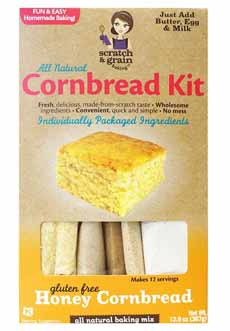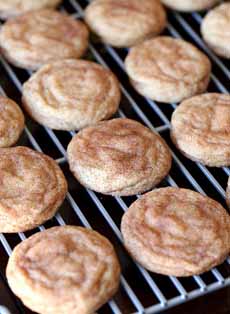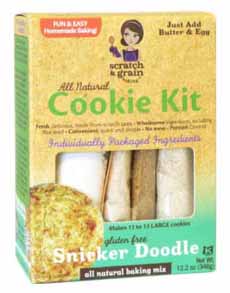GLUTEN-FREE PRODUCT: Scratch & Grain Baking Kits Are Not Just For Kids
|
Gluten-free writer Georgi Page-Smith writes that Scratch & Grain Baking Kits are not “just for kids.” While the line was created so that children could easily make a batch of cookies or brownies, the quality is so fine that households with no kids can just dig in.
During a recent cornbread jag I requested a sample of Scratch & Grain’s organic and gluten free Honey Cornbread Kit, in order to broaden my horizons and see if there was anything I was missing about the corn arts. Little did I know I was about to enter a realm of flavor and texture that was heretofore undiscovered within my experience. Scratch & Grain specializes in baking kits—conventional and gluten-free mixes for cookies, cornbread, cupcakes and more—which allow the user to compose, mix and bake their own treats from pre-portioned, labeled and numbered ingredients. This system accomplishes a few things: The gluten-free Cornbread, Snicker Doodle* and Cheesecake Brownie Kits that I tested produced tender, delicious results that I am confident will apply across the whole line. Unpacking the Honey Cornbread Kit was in itself a bit of fun. All of the ingredients are neatly packaged in clear sachets, with handy numbers on each one indicating the order in which they should be added. Helpful tips on the back of the box provide for variations and suggest add-ins. The Cornbread Kit contains a not-unreasonable level of sugar per serving (13g), but I am ever-wary of sugar and a bit of a purist. Following a tip on the box, I happily left out most of the cane sugar but used all of the honey granules and brown sugar. The results were quick to come, making me look like a domestic goddess. They were so deliciously tender, with a buttery, toasty flavor, that my spouse (normally a bit austere in his diet) ate giant pieces of it warm and then stealthily battled me for the last wedges. I did not use all the cane sugar provided in the kit, but I believe that would have yielded the sweeter, moister experience that is pleasing to many. The beauty of this cornbread is that it is appropriate for breakfast, as a mid-afternoon snack, or with a bowl of greens for dinner. This is a recipe I recommend trying, whether you are a cornbread aficionado or someone who is cornbread-curious. EDITOR’S NOTE: You can also add some minced jalapeño to a cornbread mix. It’s our favorite way to enjoy it: less sugar and a bit of heat. I will admit I have never been a huge fan of the cinnamon-sugar cookies known as snickerdoodles, though I acknowledge their place in the cookie pantheon. But Scratch & Grain’s organic, gluten-free Snicker Doodle Kit* won me over. The robust aromatics of the cinnamon and the addition of flax seeds into the dough delivered a rich, spicy and substantial cookie that would please children and adults. The dough again had a buttery, caramelly flavor that made a good vehicle for the cinnamon sugar coating. The baked cookies had an ever-so-delicate frill of crunchy caramelization around the edges, adding a new dimension to the snickerdoodle formula. Snickerdoodles tend to be fall cookies, perfect for a with apple cider or warm mulled cider, or with tea—plain black or spiced. This is the cookie to offer company for an old-fashioned welcome. It will remind guests of their favorite granny—even if she didn’t bake—it’s that cozy and comforting. I also found this kit to be a great base for other add-ins. For me it was ground black sesame seeds, but chocolate chips would create a nice fusion, too. See the history of snickerdoodle cookies below. |
 [1] Gluten-free cornbread, packaged with honey granules that you can use in the bread dough or to make honey butter.
[4] There’s also Cheesecake Brownies Kit. This photo is from The Cozy Cook, who offers her own recipe. |
|
|
CHEESECAKE BROWNIE KIT While the other kits struck a somewhat virtuous note, the Cheesecake Brownie kit was, in a word, decadent. The quality of the chocolate was elevated and not too cloyingly sweet. Even with my omission of half of the bag of chips, it delivered a rich, luxurious wave of chocolate flavor. The cream cheese streaks made a nice counterbalance to the intensity of the chocolate and coaxed me into enjoying a combination that I wouldn’t normally try. I do think you could leave the egg yolk out of the cream cheese streak and not miss it. The whole concoction stayed moist into the next day, but they may not last that long in your household! Scratch & Grain’s gluten-free line will keep me happy for quite some time, and I have no hesitation recommending any of their products for superior, wholesome flavor and ease of use. Products are available from ScratchandGrain.com and in certain Whole Foods markets. Check the the store locator. —Georgi Page-Smith |
||

recipe for a conventional cookie (not gluten-free) from Cookies And Cups. |
THE HISTORY OF SNICKERDOODLE COOKIES A snickerdoodle is a drop cookie made with butter, sugar, flour, baking soda and cream of tartar†, and rolled in cinnamon sugar. The classic recipe creates a chewy cookie with grooved lines on the surface. “Though some prefer to omit the cream of tartar in snickerdoodles,” says the Huffington Post, “purists will contest that it’s not the classic cookie without it—more like a plain cinnamon sugar cookie.” And without leavening, it’s as flat as a gingersnap—which may be what some people are looking for (we prefer the puffiness from the cream of tartar). Some recipes use eggs for a richer, moister cookie; some use oil instead of butter. Recipes can produce soft or crisp cookies. According to an extensive article on Bakemore | WordPress, the earliest known print reference dates 1889. The cookies became very popular in New England and Pennsylvania during this time. What about the name? |
|
|
*Scratch & Grain uses two words: snicker doodle. The conventional spelling is one word, snickerdoodle. †The purpose of cream of tartar, a mild acid, is to react with the baking soda to leaven the cookie (cause the dough to rise). ‡ are a cultural group formed by early German-speaking immigrants to Pennsylvania and their descendants. Most emigrated to the U.S. from Germany or Switzerland in the 17th and 18th centuries. |
||





